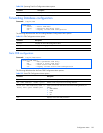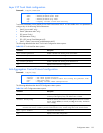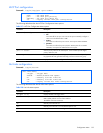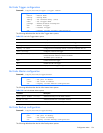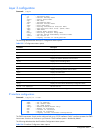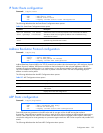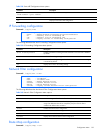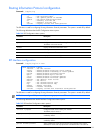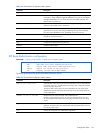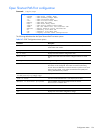
Configuration Menu 128
IP Static Route configuration
Command: /cfg/l3/route
[IP Static Route Menu]
add - Add static route
rem - Remove static route
cur - Display current static route configuration
The following table describes the Static Route Configuration Menu options.
Table 136 Static Route Configuration Menu options
Command Description
add <IP address> <IP subnet
mask> <gateway> <interface>
Adds a static route. You will be prompted to enter a destination IP address,
destination subnet mask, and gateway address. Enter all addresses using
dotted decimal notation.
rem <IP address> <IP subnet
mask>
Removes a static route. The destination address of the route to remove must be
specified using dotted decimal notation.
cur Displays the current IP configuration.
Address Resolution Protocol configuration
Command: /cfg/l3/arp
[ARP Menu]
static - Static ARP Menu
rearp - Set re-ARP period in minutes
cur - Display current ARP configuration
Address Resolution Protocol (ARP) is the TCP/IP protocol that resides within the Internet layer. ARP resolves a physical
address from an IP address. ARP queries machines on the local network for their physical addresses. ARP also
maintains IP to physical address pairs in its cache memory. In any IP communication, the ARP cache is consulted to
see if the IP address of the computer or the router is present in the ARP cache. Then the corresponding physical
address is used to send a packet.
The following table describes the ARP Configuration Menu options.
Table 137 ARP Configuration Menu options
Command Description
static Displays Static ARP menu.
rearp <2-120> Defines re-ARP period in minutes. You can set this duration between two and
120 minutes.
cur Displays the current ARP configurations.
ARP Static configuration
Command: /cfg/l3/arp/static
[Static ARP Menu]
add - Add a permanent ARP entry
del - Delete an ARP entry
cur - Display current static ARP configuration
Static ARP entries are permanent in the ARP cache and do not age out like the ARP entries that are learnt
dynamically. Static ARP entries enable the switch to reach the hosts without sending an ARP broadcast request to the
network. Static ARPs are also useful to communicate with devices that do not respond to ARP requests. Static ARPs
can also be configured on some gateways as a protection against malicious ARP Cache corruption and possible DOS
attacks.
The following table describes the Static ARP Configuration Menu options.



